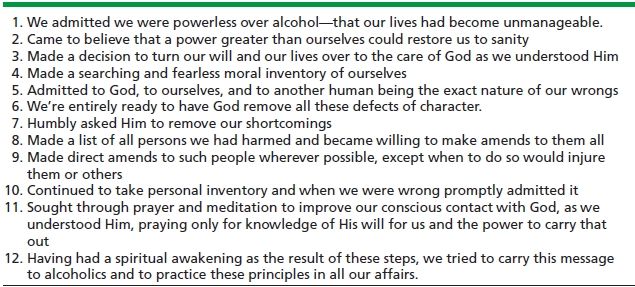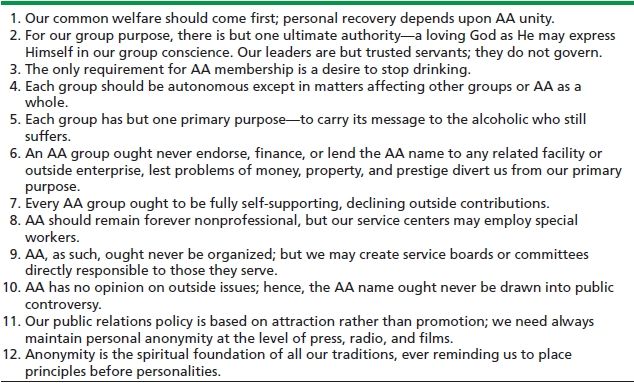Edgar P. Nace, MD
69
Twelve-Step programs are a fellowship of men and women who offer their hope, strength, and experience to anyone desiring to not drink or do drugs. Participation is anonymous, there is no cost, and questions are not asked of newcomers.
ALCOHOLICS ANONYMOUS
Alcoholics Anonymous (AA) is an organization that has a single purpose: “to carry its message to the alcoholic who still suffers.” In 2010, AA membership exceeded 2 million, and there were 115,770 groups registered. AA does not engage in fund-raising or lobbying; it endorses no causes and does not promote itself. It is interested in the alcoholic person, not alcoholism per se. AA will decline outside contributions and does not provide treatment or educational services.
AA refers to itself as a “fellowship.” A fellowship is a “mutual association of persons on equal and friendly terms; a mutual sharing, as of experience, activity, or interest.” There are no dues, but a collection is commonly taken at meetings to assure that AA remains self-supporting and not dependent on outside funds. All are welcome based on a desire to stop drinking. Admitting that one is an “alcoholic” is not necessary, nor will AA attempt to proffer a diagnosis on an attendee.
The Program
To work the AA program means to study the Twelve Steps (Table 69-1) and to follow the directions contained within these steps. In addition, AA members and AA groups will respect and adhere to the Twelve Traditions (Table 69-2). AA meetings may be “open” or “closed.” Closed meetings are for those who consider themselves alcoholics or are questioning whether they might be alcoholic. Open meetings are for anyone interested in attending a meeting. If an alcoholic person did not wish to be seen at an AA meeting except by other alcoholics, he or she would attend only closed meetings.
TABLE 69-1. THE TWELVE STEPS

TABLE 69-2. THE TWELVE TRADITIONS

A meeting is usually 1 hour in duration and may be followed by informal socializing. A “speakers” meeting will consist of a member telling her story—emphasizing “what it was like” (the drinking experience), “what happened” (the process of recognizing the consequences of drinking and doing something about it), and “what it is like now” (how life has changed since beginning recovery from alcoholism). Step meetings will focus on one of the Twelve Steps in a discussion format. Discussion meetings are those where a topic is picked (e.g., “gratitude”) and the group shares thoughts and experiences of the same.
The Birth of Alcoholics Anonymous
AA was founded in Akron, Ohio, in 1935 by Bill Wilson and Dr. Bob Smith. By 1950, there were about 90,000 members. A 2007 survey by the General Service Office of AA estimated that worldwide, there were nearly 2 million members with about 1.2 million of these members being in the United States. Members reported attending an average of 2.4 AA meetings a week, and 79% of members had an AA sponsor.
NARCOTICS ANONYMOUS
NA is the second largest Twelve-Step program focused on substance use disorders. NA grew out of AA in Los Angeles in the late 1940s and follows the format of AA with its Twelve Steps and Twelve Traditions. NA substituted the word “addiction” for alcohol, removing drug-specific references. NA is open to all drug addicts without regard to the type of drug or combination of drugs.
NA literature describes the purpose of NA as follows:
“NA is a nonprofit fellowship or society of men and women for whom drugs had become a major problem. We … meet regularly to help each other stay clean. … We are not interested in what or how much you used … but only in what you want to do about your problem and how we can help.” NA members are likely, on the average, to be younger than AA members. NA in its 2009 survey reports that 2% are under age 20, 14% age 21 to 30 (contrasting with 8% per the 2007 AA survey), and only 4% over age 60 (contrasting with AA with over 16% over age 60).
COCAINE ANONYMOUS
CA began in Los Angeles in 1982. CA is adapted from the AA program and follows the Twelve-Step model. It is open to all individuals who want to stop using cocaine as well as all other mind-altering substances. As of 1996, membership was estimated to be 30,000 members in 2,000 groups.
MARIJUANA ANONYMOUS
Marijuana Anonymous (MA) was founded in 1989 and is based on the Twelve-Step program of AA. MA is for those who experience marijuana as controlling their lives.
NICOTINE ANONYMOUS
Nicotine Anonymous, formerly Smokers Anonymous, was founded in the early 1980s and is modeled on AA. Nicotine Anonymous, as with other Twelve-Step programs, emphasizes that the user is neither unique nor alone.
AL-ANON AND ALATEEN
Al-Anon was founded in 1951 by Lois Wilson, the wife of AA cofounder Bill Wilson. Al-Anon is an international fellowship of friends or relatives of alcoholics who have been impacted by another’s drinking. They share their experience, strength, and hope and follow their own Twelve-Step format. Al-Anon is not family or group therapy and does not provide counseling in any formal sense. Alateen grew out of Al-Anon and is for teenagers 13 to 17. Al-Anon meetings will focus not on the drinker, but on the family members or friends of a drinker who tolerate abuse, or indulge in excessive caretaking, and who may have developed low self-esteem because they think that they should be able to help the alcoholic stop drinking.
PHYSICIAN FACILITATION OF TWELVE-STEP PARTICIPATION
Physicians and other clinicians should inform patients of the existence, format, and benefits of participating in a Twelve-Step program. This recommendation is based on empirical evidence that AA participation (and by extension use of other Twelve-Step programs) and engagement/commitment to AA are consistent predictors of positive outcomes for addicted individuals.
OUTCOME STUDIES
Support for encouraging AA (and by extension other Twelve-Step programs) is found in several large studies. One study compared alcoholics randomly assigned to cognitive–behavioral therapy, motivational treatment (MT), and Twelve-Step facilitation (TSF). TSF is a professionally led group therapy, which points patients to Twelve-Step participation. TSF patients had significantly higher rates of abstinence at 1-year and 3-year follow-ups. Another study among US veterans found that at 1 year and at 18 months, those patients whose aftercare was only AA or another Twelve-Step program had abstinence rates twice those who did not attend any Twelve-Step program. There is some evidence that the number of meetings attended functions in a dose–response relationship.
KEY POINTS
1. The purpose of AA is to assist the suffering alcoholic achieve sobriety, and it is not involved in treatment, research, or social and political issues.
2. The only criterion for attending AA meetings is a desire not to drink.
3. Physicians should be familiar with Twelve-Step programs and encourage patients with substance use disorders to participate.
REVIEW QUESTIONS
1. Better outcomes from Twelve-Step participation are likely if one:
Stay updated, free articles. Join our Telegram channel

Full access? Get Clinical Tree


